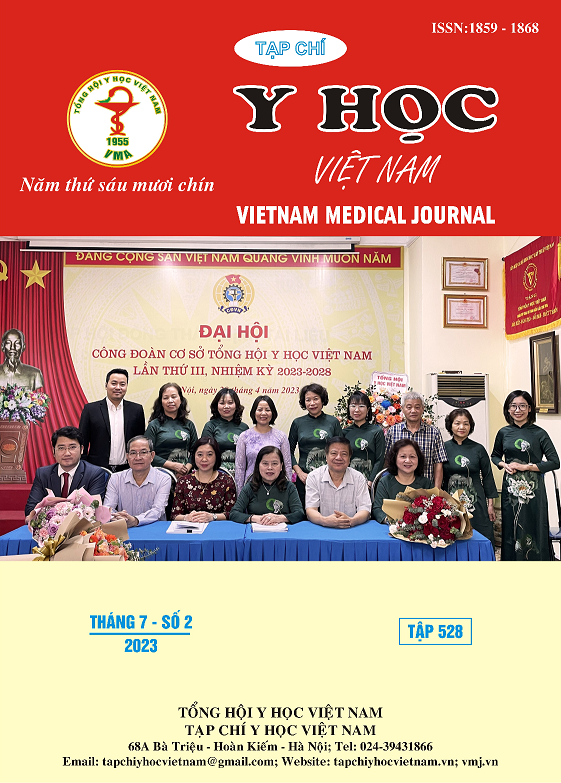DETERMINATION OF THE RATE OF BACTERIA CAUSING CHRONIC SINUSITIS AT TRA VINH GENERAL HOSPITAL IN 2022
Main Article Content
Abstract
Background: Infectious rhinosinusitis is a common disease, especially in countries with hot and humid tropical climates, poor sanitation and severe environmental pollution. Vietnam has about 2-5% of the population suffering from sinusitis. Chronic bacterial sinusitis, if left untreated, can cause serious complications such as otitis media, meningitis, encephalitis, lateral vein inflammation, eye complications such as blepharitis, blepharitis, and cystitis. lacrimation, conjunctivitis, orbital inflammation, orbital abscess, postglomerular neuritis, lower respiratory tract inflammation [2]. Vietnam is located in an area with the highest rate of antibiotic-resistant bacteria in the world, so the identification of pathogenic bacteria and treatment according to the antibiotic map contributes significantly to the success of treatment and reduction of antibiotic resistance. antibiotic resistance. Objective: Determining the prevalence of bacteria causing chronic rhinosinusitis in adults. Methods: A prospective study describing a series of cases performed on 79 patients diagnosed with chronic rhinosinusitis who were taken for bacterial identification testing at Tra Vinh General Hospital from January 2021 to October 2022. Results: Among the 79 studied patients who received bacterial culture, 60/79 samples had bacteria growing, accounting for 76%. Among the 60 cases of bacterial growth, the highest rate was S.epidermidis with 23/60 cases, accounting for 38.3%, followed by S. aureus with 11/60 cases, accounting for 18.3%. Enterobacter cloacae had 10/60 cases, accounting for 16.7%, Escheriachia Coli had 5/60 cases, accounting for 8.3%, Klebsiella pneumoniae had 4/60 cases, accounting for 6.7%. Pseudomonas aeruginosa group had 7/60 cases, accounting for 11.7%. Conclusion: Bacterial culture results identified 3 groups of pathogenic bacteria in adult bacterial infections: staphylococcus aureus group accounted for the highest proportion in which S.epidermidi 38.3% and S. aureus 18.3%. Enterobacteriaceae family of Gram-negative bacteria has 3 species: Enterobacter cloacae 16.7%, Escheriachia Coli 8.3% and Klebsiella pneumoniae 6.7%. Pseudomonas aeruginosa group accounted for 11.7%.
Article Details
Keywords
Bacterial, Chronic sinusitis, Tra Vinh
References
2. Lê Công Định (2012), "Cập nhật những quan điểm mới về chẩn đoán và điều trị viêm mũi xoang", Tạp chí Y Học Việt Nam, Tập 1, tr.90-93.
3. Nguyễn Văn Hòa (2016), "Nghiên cứu đặc điểm lâm sàng, vi khuẩn trong viêm mũi xoang mạn tính nhiễm khuẩn người lớn tại Bệnh viện tai mũi họng Trung Ương", Luận văn thạc sỹ y học, Trường Đại học Y Hà Nội.
4. Bùi Thế Hưng, Trần Minh Trường (2019), "Tình hình nhiễm khuẩn và đề kháng kháng sinh trong bệnh lý viêm xoang mạn tính có chỉ định phẫu thuật tại Bệnh viện Chợ Rẫy", Tạp chí Y học TP. Hồ Chí Minh, Tập 3, tr. 52-57.
5. Trịnh Thị Hồng Loan (2003),“Viêm mũi xoang mạn tính và hiện tượng kháng kháng sinh hiện nay”, Luận văn tốt nghiệp Bác sỹ Đa khoa, Trường Đại học Y Hà Nội.
6. Chan J, H.J. (2001), "The microbiology of chronic rhinosinusitis: results of a community surveillance study, Ear, Nose, and Throat Journal", pp. 143-145.
7. Fokkens, W. J., et al. (2020), "Executive summary of EPOS 2020 including integrated care pathways", Rhinology. 58(2), pp. 82-111.
8. Pleis, J. R., Lucas, J. W., and Ward, B. W. (2009), "Summary health statistics for U.S. adults: National Health Interview Survey, 2008", Vital Health Stat 10(242), pp. 1-157.
9. Potter, G. D. (1981), "Sinus anatomy and pathology", Bull N Y Acad Med. 57(7), pp. 591-604.


